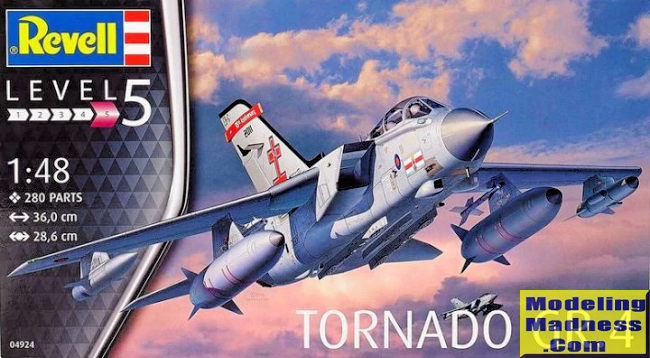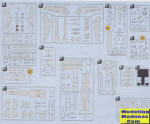
Revell 1/48 Tornado GR.4
| KIT #: | 04924 |
| PRICE: | @$20.00 from an on-line sales page |
| DECALS: | Two options |
| REVIEWER: | Scott Van Aken |
| NOTES: | 2015 release |

| HISTORY |
The Panavia Tornado is a family of twin-engine, variable-sweep wing multirole combat aircraft, jointly developed and manufactured by Italy, the United Kingdom, and West Germany. There are three primary Tornado variants: the Tornado IDS (interdictor/strike) fighter-bomber, the suppression of enemy air defences Tornado ECR (electronic combat/reconnaissance) and the Tornado ADV (air defence variant) interceptor aircraft.
The Tornado was developed and built by Panavia Aircraft GmbH, a tri-national consortium consisting of British Aerospace(previously British Aircraft Corporation), MBB of West Germany, and Aeritalia of Italy. It first flew on 14 August 1974 and was introduced into service in 1979–1980. Due to its multirole design, it was able to replace several different fleets of aircraft in the adopting air forces. The Royal Saudi Air Force (RSAF) became the only export operator of the Tornado in addition to the three original partner nations. A tri-nation training and evaluation unit operating from RAF Cottesmore, the Tri-National Tornado Training Establishment, maintained a level of international co-operation beyond the production stage.
The Tornado was operated by the Royal Air Force (RAF), Italian Air Force, and RSAF during the Gulf War of 1991, in which the Tornado conducted many low-altitude penetrating strike missions. The Tornados of various services were also used in conflicts in the former Yugoslavia during the Bosnian War and Kosovo War, the Iraq War, Libya during the Libyan civil war, as well as smaller roles in Afghanistan, Yemen, and Syria. Including all variants, 992 aircraft were built.
The RAF retired their last plane in April 2019. The type is still in service with Germany, Italy, and Saudi Arabia.
| THE KIT |
 This
is not the only Tornado GR kit around. Airfix and ESCI released one some time
ago and more recently there has been a Hobby Boss kit. The only one I have built
was the ESCI offering and it was a real putty monster. This one looks quite nice
in its very large box, with engraved panel lines and nice detail typical of
Revell Germany kits.
This
is not the only Tornado GR kit around. Airfix and ESCI released one some time
ago and more recently there has been a Hobby Boss kit. The only one I have built
was the ESCI offering and it was a real putty monster. This one looks quite nice
in its very large box, with engraved panel lines and nice detail typical of
Revell Germany kits.
The cockpit is nicely done with raised instrument details. You are also provided decals should you wish to use them. The seats are adequate and include belt detail. One needs to open holes in the lower fuselage piece before installing the nose gear well onto which the cockpit tub fits. Once that is done, the rest of the cockpit bits can be added.
One then moves to installing the gear wells, engine faces and ducting before attaching the two forward fuselage halves. Again, you have to choose whether to open holes for the air refueling probe housing. Then we move on to the side fuselage panels and the intakes. The attachment points for the swing wings are next before setting this aside to cure.
Wings have the ability to have the flaps deployed. When that is chosen, you cannot move the wings, so a choice needs to be made before assembling the wings. There are pivot pieces for the wing pylons that must be installed prior to fully assembling the wings. One attaches the lower wings along with the attached hinges and then puts the upper wing halves in place. This is capped by a reinforcement to keep the wings lined up. Then you need to choose if you want to modify the fold blanking pieces for rear swept wings or keep them as they are for the forward sweep.
Once that is accomplished one moves to assembling the upper fuselage piece and then attaching it along with some other bits to the rest of the fuselage. Then the exhaust area is built up, which includes the tail pipes and the turner cans. The fin gets an insert or two and some cutting before it is assembled. Only now is the nose cone attached and while weight is shown, the amount is not. Fortunately, there is considerable room for it.
The rudder and other fin bits are now attached and the stabs assembled and glued in place. It is only now that the flaps and slats are installed. In the extended position, the slats require slat tracks glued on and the flaps require assembly. If going with the wings folded back, the number of bits attached for these items is considerably less. You can also pose the speed brakes open or closed. Rarely were they left open on the ground, but the choice is yours. you can also do the same for the thrust reversers. Again, these were rarely in any position other than stowed unless being used.
Several pages are dedicated to building up and
installing the pylons as well as the landing gear and doors. One then returns to
the cockpit to add more black boxes and build up the canopy, which can be posed
open. A bunch of sensors and antennas followed by stores is next. You get two drop tank sizes, Sidewinders, and a pair of ECM pods for
the wings. Unfortunately, there is nothing for the centerline bomb racks so you
need to scrounge these from other sources. If it helps, these planes normally
only carried fuel tanks unless doing some sort of practice missions. Even then,
the pods would be about it.
next. You get two drop tank sizes, Sidewinders, and a pair of ECM pods for
the wings. Unfortunately, there is nothing for the centerline bomb racks so you
need to scrounge these from other sources. If it helps, these planes normally
only carried fuel tanks unless doing some sort of practice missions. Even then,
the pods would be about it.
Instructions are very good with all paints using Revell paint numbers. Several of the colors will need to be mixed. The decals sheet is quite extensive and includes markings for two squadrons. One is a general plane from 617 squadron and the other is the box art plane from 41 squadron that celebrates its 95th Anniversary. The sheet includes stencils for all the stores and for the pylons as well. There are aftermarket sheets available if you want to do something else, and I'd like to plug the latest from Euro Decals as a good choice.
| CONCLUSIONS |
This won't be a weekend special and should take a fairly good amount of time to build. The aircraft could probably be built as a GR.1 if you so wish as the majority of modifications to GR.4 were avionics. I'm not sure how this compares to the Hobby Boss kit, but I was able to find my copy at a considerably lower price that what the HB kit is selling for. I do miss the fact that there is no ordnance, but again, these planes flew 99% of their missions unarmed so that shouldn't be much of an issue to most.
| REFERENCES |
https://en.wikipedia.org/wiki/Panavia_Tornado
July 2019 Copyright ModelingMadness.com.
All rights reserved. If you would like your product reviewed fairly and fairly quickly, please contact the editor or see other details in the
Note to
Contributors. Back to the Main Page
Back to the Review
Index Page
Back to the Previews Index Page